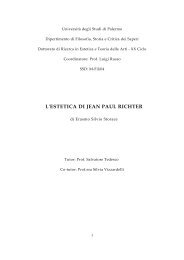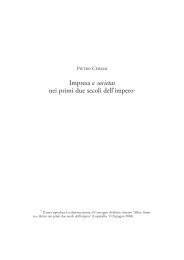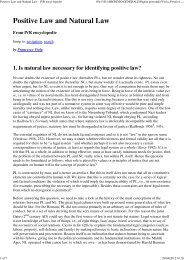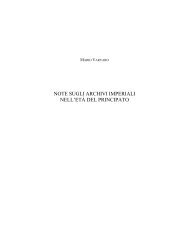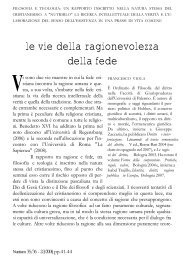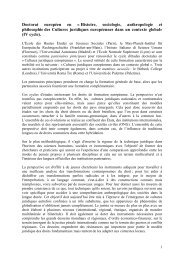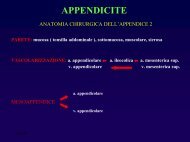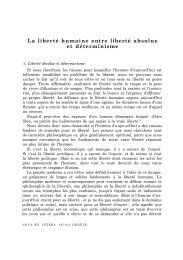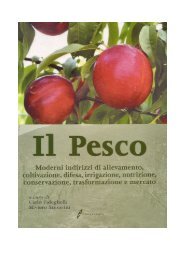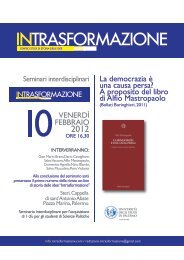M. VARVARO, Gai 4.163 e la struttura della formula arbitraria nell ...
M. VARVARO, Gai 4.163 e la struttura della formula arbitraria nell ...
M. VARVARO, Gai 4.163 e la struttura della formula arbitraria nell ...
You also want an ePaper? Increase the reach of your titles
YUMPU automatically turns print PDFs into web optimized ePapers that Google loves.
M. Varvaro, <strong>Gai</strong> <strong>4.163</strong> e <strong>la</strong> <strong>struttura</strong> del<strong>la</strong> formu<strong>la</strong> <strong>arbitraria</strong> [p. 705-734]<br />
Per poter agire sine poena, dunque, il destinatario dell’interdetto<br />
avrebbe dovuto chiedere una formu<strong>la</strong> <strong>arbitraria</strong>, sul<strong>la</strong> base del<strong>la</strong> quale,<br />
effettuata <strong>la</strong> litis contestatio, l’arbiter avrebbe proceduto a giudicare. 7<br />
Benché si sia pensato il contrario, il modo in cui <strong>Gai</strong>o si esprime non<br />
<strong>la</strong>scia credere che anche chi avesse chiesto al magistrato l’emanazione<br />
dell’interdetto avrebbe potuto richiedere <strong>la</strong> nomina dell’arbiter. 8<br />
Proprio <strong>la</strong> richiesta di un arbiter ha indotto alcuni studiosi a pensare<br />
che <strong>la</strong> formu<strong>la</strong> venisse chiamata <strong>arbitraria</strong> per questa ragione. 9 In<br />
—————————<br />
7 In proposito può ricordarsi che A. UBBELOHDE, in F. GLÜCK, Commentario, XLIII-<br />
XLIV, cit. (nt. 3), 497, nt. 31, e 549, nt. 3, ha pensato che l’arbiter fosse scelto dalle parti,<br />
e che so<strong>la</strong>mente in mancanza di un accordo fosse individuato dal magistrato. Questa<br />
ipotesi si base su quanto si legge in D. 43.24.21 pr. (Pomp. 29 ad Sab.): ...a iudi-ce, qui<br />
ex hoc interdicto sumptus esset rell.<br />
8 Così S.W. ZIMMERN, Der römische Zivilprozeß, III, cit. (nt. 3), 221, G.F. PUCHTA,<br />
Cursus der Institutionen, II 7 , cit. (nt. 3), 136, nonché, sia pur cautamente, F.C. VON<br />
SAVIGNY, System des heutigen römischen Rechts, V, Berlin 1841, 499; implicitamente anche<br />
W.B. LEIST, Die Bonorum possessio, I, cit. (nt. 3), 351; con maggiore decisione, K.A.<br />
SCHMIDT, Das Interdiktenverfahren, cit. (nt. 3), 268-270, il quale a tale proposito<br />
adduceva anche l’esistenza di un iudicium calumniae quartae partis che, secondo <strong>la</strong> lezione<br />
del palinsesto veronese delle Istituzioni a lui nota (ma dubbia: v. infra, nt. 33), sarebbe<br />
stato attestato in <strong>Gai</strong> 4.175 proprio in re<strong>la</strong>zione al procedimento interdittale; così anche<br />
H. WITTE, Das interdictum uti possidetis als Grund<strong>la</strong>ge des heutigen Possessorium<br />
ordinarium, Leipzig 1863, 2; M.A. VON BETHMANN-HOLLWEG, Der römische<br />
Civilprozess, II, cit. (nt. 3), 365, nt. 107. In senso contrario si sono espressi A.<br />
UBBELOHDE, in F. GLÜCK, Commentario, XLIII-XLIV, cit. (nt. 3), 555 s., anche sul<strong>la</strong><br />
base del<strong>la</strong> diversa lezione del palinsesto veronese stabilita in base al riesame di Studemund<br />
(v. infra, nt. 33); PH.E. HUSCHKE, <strong>Gai</strong>us. Beiträge zur Kritik und zum Verständniß seiner<br />
Institutionen. Mit einer Zugabe über die K<strong>la</strong>gformeln in der Lex Rubria, Leipzig 1855, 201 s.<br />
9 Così già [PH.]E. HUSCHKE, Die Multa und das Sacramentum in ihren verschiedenen<br />
Anwendungen, Leipzig 1874, 77, nt. 185, e poi, con maggiore ampiezza di argomentazione,<br />
B. BIONDI, Studi sulle actiones <strong>arbitraria</strong>e e l’arbitrium iudicis, Palermo 1913,<br />
7-12, seguìto da E. LEVY, Zur Lehre von den sog. actiones <strong>arbitraria</strong>e, in SZ 36, 1915, 15<br />
(= Gesammelte Schriften, I, Köln-Graz 1963, 332), sul<strong>la</strong> scorta del<strong>la</strong> considerazione che<br />
pure nel procedimento cum poena <strong>la</strong> formu<strong>la</strong> del iudicium Cascellianum siue secutorium<br />
avrebbe contenuto una c<strong>la</strong>uso<strong>la</strong> restitutoria o esibitoria. Al di là delle obiezioni già<br />
avanzate dal<strong>la</strong> storiografia (v. nt. seguente), il rilievo non appare in sé decisivo. Infatti,<br />
così come <strong>la</strong> formu<strong>la</strong> <strong>arbitraria</strong> avrebbe potuto essere denominata in questo modo in base<br />
al<strong>la</strong> caratteristica più appariscente del suo programma di giudizio, che prevedeva una<br />
c<strong>la</strong>uso<strong>la</strong> <strong>arbitraria</strong>, il iudicium del procedimento cum poena era chiamato Cascellianum per<br />
ricordare il giurista che lo aveva introdotto (in questo caso, verosimilmente, Aulo<br />
Cascellio: v. M. BRETONE, Storia del diritto romano 13 , Roma-Bari 2010, 173 s.; v. anche<br />
H. DERNBURG, System des römischen Rechts der Pandekten 8 , bearbeitet von P.<br />
SOKOLOWSKI, Berlin 1912, 282, nt. 3, il quale ricorda che il pretore Cascellio fu contem-<br />
710 AUPA 55/2012



